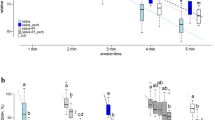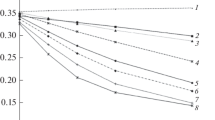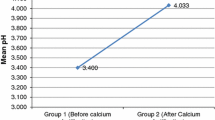Abstract
Lysozyme is among the most protective enzymes in the pellicle layer. The aim of the present study was to establish a precise fluorimetric assay for determination and characterisation of lysozyme activity immobilised in the initial in situ formed pellicle. For in situ pellicle formation, bovine enamel slabs were fixed on maxillary splints and carried by six subjects for different times (3, 30 min) on buccal and palatal sites. The enzymatic assay was based on hydrolysis of cell walls from Micrococcus lysodeicticus linked to a fluorogenic substance. When the substrate is hydrolysed, a fluorescing product is released. Furthermore, the effects of chlorhexidine and black tea on lysozyme in the in situ pellicle were investigated. The fluorimetric method allowed direct determination of the enzyme activity with the slab inside the well of a microtiter plate. The mean immobilised activity over all samples amounted to 68.67 ± 27.35 U/cm2 (desorbed activity = 46.76 ± 21.18 U/cm2). The enzyme activity exposed at the pellicles’ surfaces increased in a time-dependant manner and showed a Michaelis–Menten kinetic. Chlorhexidine and black tea reduced lysozyme activity of the in situ pellicle significantly. After rinsing with tea or chlorhexidine, V max was reduced, whereas K m remained unaffected indicating a negative allosteric effect of the V type. The fluorimetric method is appropriate for determination of pellicle lysozyme activity. The influence of effectors on immobilised lysozyme activity can be monitored.






Similar content being viewed by others
References
Baxter NJ, Lilley TH, Haslam E, Williamson MP (1997) Multiple interactions between polyphenols and a salivary proline-rich protein repeat result in complexation and precipitation. Biochemistry 36:5566–5577
Bennick A (2002) Interaction of plant polyphenols with salivary proteins. Crit Rev Oral Biol Med 13:184–196
Charlton AJ, Baxter NJ, Khan ML, Moir AJ, Haslam E, Davies AP, Williamson MP (2002) Polyphenol/peptide binding and precipitation. J Agric Food Chem 50:1593–1601
Deimling D, Hannig C, Hoth-Hannig W, Schmitz P, Schulte-Monting J, Hannig M (2007) Non-destructive visualisation of protective proteins in the in situ pellicle. Clin Oral Investig 11:211–216
Fleming A (1922) On a remarkable bacteriolytic element found in tissues and secretions. Proc R Soc Lond 93B:306–317
Gendron R, Grenier D, Sorsa T, Mayrand D (1999) Inhibition of the activities of matrix metalloproteinases 2, 8, and 9 by chlorhexidine. Clin Diagn Lab Immunol 6:437–439
Gorin G, Wang SF, Papapavlou L (1971) Assay of lysozyme by its lytic action on M. lysodeicticus cells. Anal Biochem 39:113–127
Hannig C, Attin T, Hannig M, Henze E, Brinkmann K, Zech R (2004) Immobilisation and activity of human alpha-amylase in the acquired enamel pellicle. Arch Oral Biol 49:469–475
Hannig C, Hannig M, Attin T (2005) Enzymes in the acquired enamel pellicle. Eur J Oral Sci 113:2–13
Hannig C, Hoch J, Becker K, Hannig M, Attin T (2005) Lysozyme activity in the initially formed in situ pellicle. Arch Oral Biol 50:821–828
Hannig C, Spitzmüller B, Knausenberger S, Hoth-Hannig W, Hellwig E, Hannig M (2008) Detection and activity of peroxidase in the in situ formed enamel pellicle. Arch Oral Biol 53:849–858
Hannig C, Spitzmüller B, Miller M, Hellwig E, Hannig M (2008) Intrinsic enzymatic crosslinking and maturation of the in situ pellicle. Arch Oral Biol 53:416–422
Hannig M, Joiner A (2006) The structure, function and properties of the acquired pellicle. In: Duckworth R (ed) The teeth and their environment. Monographs in oral science. Karger, Basel, pp 29–64
Hawiger J (1968) Purification and properties of lysozyme produced by Staphylococcus aureus. J Bacteriol 95:376–384
Kusano R, Andou H, Fujieda M, Tanaka T, Matsuo Y, Kouno I (2008) Polymer-like polyphenols of black tea and their lipase and amylase inhibitory activities. Chem Pharm Bull (Tokyo) 56:266–272
Lendenmann U, Grogan J, Oppenheim FG (2000) Saliva and dental pellicle—a review. Adv Dent Res 14:22–28
Maeda H (1980) A new lysozyme assay based on fluorescence polarization or fluorescence intensity utilizing a fluorescent peptidoglycan substrate. J Biochem 88:1185–1191
Nanjo F, Sakai K, Usui T (1988) p-Nitrophenyl penta-N-acetyl-beta-chitopentaoside as a novel synthetic substrate for the colorimetric assay of lysozyme. J Biochem (Tokyo) 104:255–258
Pruitt KM, Caldwell RC, Jamieson AD, Taylor RE (1969) The interaction of salivary proteins with tooth surface. J Dent Res 48:818–823
Qvarnström M, Janket SJ, Nuutinen P, Furuholm J, Meurman JH (2007) Salivary constituents and acidogenic microbial counts in coronary artery bypass graft patients from baseline to three-years after operation. Clin Oral Investig 11:217–223
Radford JR, Homer KA, Naylor MN, Beighton D (1992) Inhibition of human subgingival plaque protease activity by chlorhexidine. Arch Oral Biol 37:245–248
Scheie AA, Kjeilen JC (1987) Effects of chlorhexidine, NaF and SnF2 on glucan formation by salivary and culture supernatant GTF adsorbed to hydroxyapatite. Scand J Dent Res 95:532–535
Shimada T (2006) Salivary proteins as a defense against dietary tannins. J Chem Ecol 32:1149–1163
Smolelis AN, Hartsell SE (1949) The determination of lysozyme. J Bacteriol 58:731–736
Vray B, Hoebeke J, Saint-Guillain M, Leloup R, Strosberg AD (1980) A new quantitative fluorimetric assay for phagocytosis of bacteria. Scand J Immunol 11:147–153
Wang YB, Germaine GR (1993) Effects of pH, potassium, magnesium, and bacterial growth phase on lysozyme inhibition of glucose fermentation by Streptococcus mutans 10449. J Dent Res 72:907–911
Acknowledgement
The study was supported by a grant from the DFG (Deutsche Forschungsgemeinschaft, no. HA 5192/1-2, no. HA 2718/3–3). The authors declare that they have no conflict of interest.
Author information
Authors and Affiliations
Corresponding author
Rights and permissions
About this article
Cite this article
Hannig, C., Spitzmüller, B. & Hannig, M. Characterisation of lysozyme activity in the in situ pellicle using a fluorimetric assay. Clin Oral Invest 13, 15–21 (2009). https://doi.org/10.1007/s00784-008-0213-9
Received:
Accepted:
Published:
Issue Date:
DOI: https://doi.org/10.1007/s00784-008-0213-9




